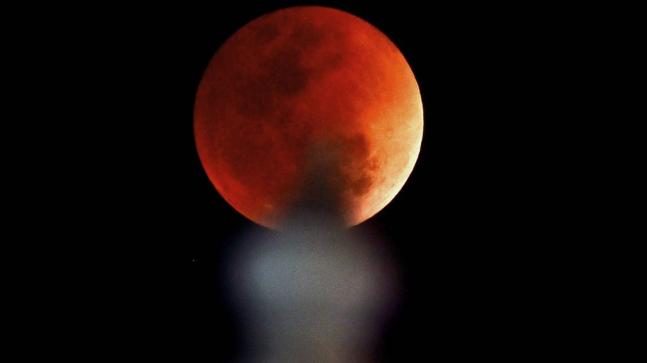
Moon does three-in-one, gazers watch red moon, super moon, eclipse
The moon put up a striking celestial show Wednesday night as a coppery red orb rose high up in the sky to mark a rare lunar eclipse that drew astronomy enthusiasts to different planetariums across the country.
The year's first total lunar eclipse was partially visible from India. The second such eclipse on July 28 will be entirely visible from India, said Arvind Paranjpye, director of the Nehru Planetarium, Mumbai.
The moon outdid itself in donning three roles. After decades, moon-gazers saw a super moon, when it looks bigger and brighter than ever because it is closer to the earth, a blue moon, which is the second full moon in a calendar month, and a blood moon, a reference to the red colour of an eclipse.
 It was, as enthusiasts gushed, truly a once-in-a-blue- moon phenomenon, visible across several parts of the world.
Moon-gazers gathered in planetariums in Delhi, Pune, Kolkata and elsewhere for a guided observation of the rare treat.
In Delhi's India Gate area, scores of students came together to have a look at the moon, which was initially, much to their disappointment, covered by clouds. But the clouds lifted, and soon the red moon was visible to the naked eye.
It was, as enthusiasts gushed, truly a once-in-a-blue- moon phenomenon, visible across several parts of the world.
Moon-gazers gathered in planetariums in Delhi, Pune, Kolkata and elsewhere for a guided observation of the rare treat.
In Delhi's India Gate area, scores of students came together to have a look at the moon, which was initially, much to their disappointment, covered by clouds. But the clouds lifted, and soon the red moon was visible to the naked eye.
 Paranjpye said the Nehru Planetarium in Mumbai was visited by 2,500-3,000 people eager to know more about the celestial phenomena.
"I am glad about the number of people who visited us considering the superstitions behind eclipses," he said. Among some communities, an eclipse is considered inauspicious.
There will be five eclipses in 2018, out of which three will be partial solar eclipses on February 15, July 13 and August 11 but which will not visible from India, Paranjpye added.
During a lunar eclipse, the shadow of earth can be seen travelling across the lunar disc. There are three stages of a total lunar eclipse - penumbral, umbral and totality.
The moon is about 3.84 lakh km from the Earth. At this distance, the shadow of the earth has both umbra and penumbra.
"During a total lunar eclipse, the moon first enters the penumbral shadow of earth. This shadow is very faint and, very often, the beginning of this phase of the eclipse is missed by a casual observer," Paranjpye said.
The progress of the penumbral shadow b
Paranjpye said the Nehru Planetarium in Mumbai was visited by 2,500-3,000 people eager to know more about the celestial phenomena.
"I am glad about the number of people who visited us considering the superstitions behind eclipses," he said. Among some communities, an eclipse is considered inauspicious.
There will be five eclipses in 2018, out of which three will be partial solar eclipses on February 15, July 13 and August 11 but which will not visible from India, Paranjpye added.
During a lunar eclipse, the shadow of earth can be seen travelling across the lunar disc. There are three stages of a total lunar eclipse - penumbral, umbral and totality.
The moon is about 3.84 lakh km from the Earth. At this distance, the shadow of the earth has both umbra and penumbra.
"During a total lunar eclipse, the moon first enters the penumbral shadow of earth. This shadow is very faint and, very often, the beginning of this phase of the eclipse is missed by a casual observer," Paranjpye said.
The progress of the penumbral shadow b ecomes apparent when more than half of the moon is covered by it.
"The umbral shadow of the earth on the moon is very distinct and its progress can be easily noticed. When the moon is entirely covered by the umbral shadow, it is a total lunar eclipse. After this, the moon comes out of the shadow of the earth in a reverse sequence," he added.
During the total phase of a lunar eclipse, the moon appears red in colour, he pointed out.
The total lunar eclipse of December 10, 1992, was so dark that for a while the moon appeared to have vanished altogether and the sky was as dark as that on a new moon night, Paranjpye added. PTI
ecomes apparent when more than half of the moon is covered by it.
"The umbral shadow of the earth on the moon is very distinct and its progress can be easily noticed. When the moon is entirely covered by the umbral shadow, it is a total lunar eclipse. After this, the moon comes out of the shadow of the earth in a reverse sequence," he added.
During the total phase of a lunar eclipse, the moon appears red in colour, he pointed out.
The total lunar eclipse of December 10, 1992, was so dark that for a while the moon appeared to have vanished altogether and the sky was as dark as that on a new moon night, Paranjpye added. PTI
